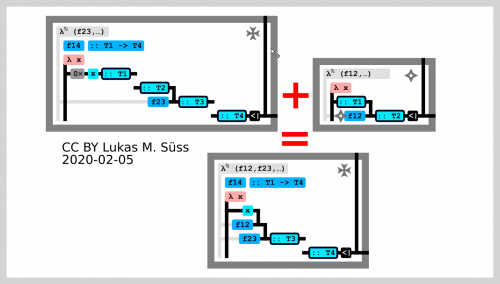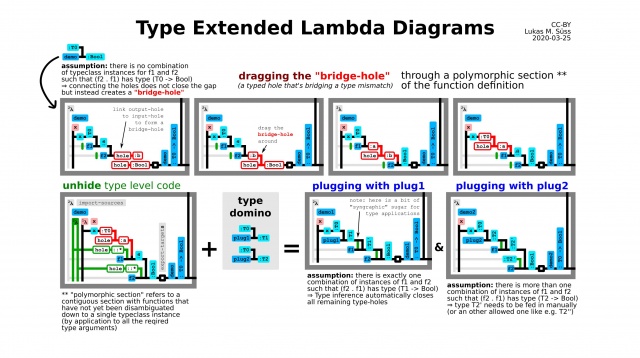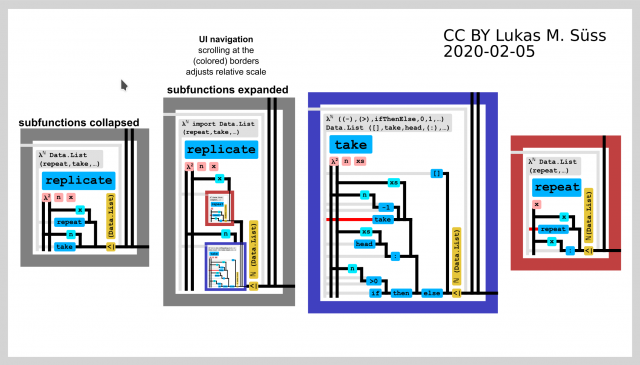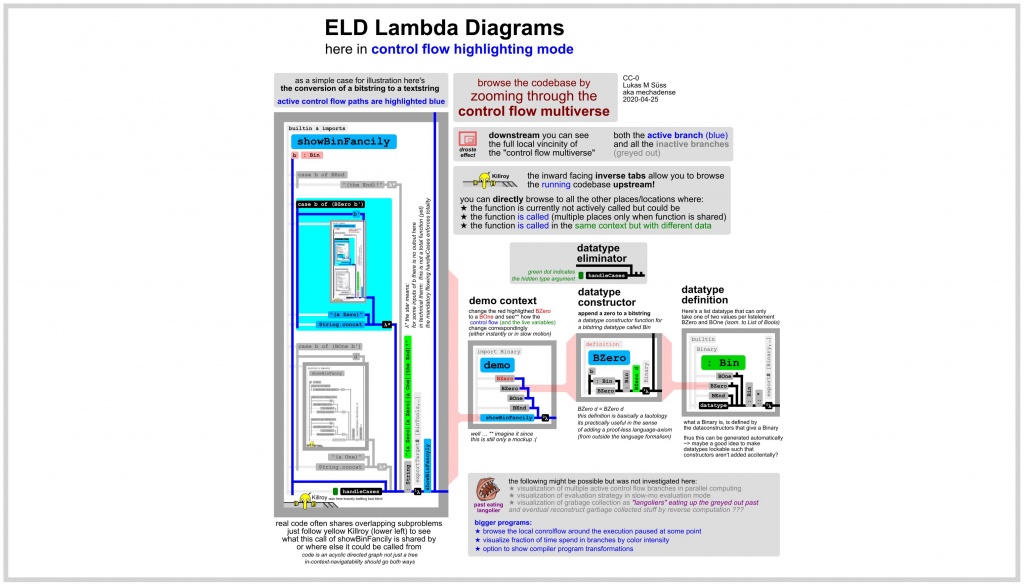Difference between revisions of "Annotated lambda diagram"
(→"Inverse tabs" for browsing the whole codebase graph rather than only the local code dependency tree: added quite a bit of content) |
(→From in scaled down place preview to zooming user interface: added some maybe critical ideas) |
||
| Line 107: | Line 107: | ||
| [[File:AnnoLamDiag ScaledDownInPlacePreview.png|640px|thumb|right|In place code preview in annotated lambda diagrams]] | | [[File:AnnoLamDiag ScaledDownInPlacePreview.png|640px|thumb|right|In place code preview in annotated lambda diagrams]] | ||
|} | |} | ||
| + | |||
| + | This mockup was put together in order to illustrate how [[annotated lambda diagram]]s would allow for <br> | ||
| + | an (adjustably) scaled-down in-place preview of functions on which the currently looked at function depends on. <br> | ||
| + | |||
| + | Specifically this random example code (the "replicate"-function) takes a value and a natural number and <br> | ||
| + | returns a list of copies of that value with the length of that natural number. | ||
| + | |||
| + | '''In place preview:''' <br> | ||
| + | Check out the "replicate"-function (grey border). <br> | ||
| + | Looking closely into the expanded version (second from left) you can see: | ||
| + | * the scaled down "in place preview" of the "take"-function (blue border) and | ||
| + | * the scaled down "in place preview" of the "repeat"-function (red border) | ||
| + | |||
| + | ---- | ||
| + | '''This is not yet an evaluating substitution!''' <br> | ||
| + | Note that (despite this looking like a substitution) this is only just a yet-unevaluated in-place-preview. <br> | ||
| + | This is important. This is very different to "conventional" box and wire graphical programming. <br> | ||
| + | <small>(matching the structure of the plain [[lambda diagrams]])</small> | ||
| + | |||
| + | Actual honest-to-goodness evaluation amounts to short-circuiting: | ||
| + | * vertical-abstraction-lines (always on the right) with | ||
| + | * vertical application-lines (always on the left). | ||
| + | That entails: | ||
| + | * all abstraction lines of the substituted in function that got saturated just vanish <small>(note that partial application is allowed)</small> | ||
| + | * what was formally supplied via the lines now gone is now supplied by the abstraction lines of the callee | ||
| + | * former guts of the now substituted-in function are now arbitrarily complexly intertwined into the calling function | ||
| + | Note that with true substituting evaluation there is a loss decomposition. <br> | ||
| + | <small>Creating complex patterns from simple rules is the point of programming after all.</small><br> | ||
| + | |||
| + | Is this true?: Classical box-and-wire graphical programming cannot make a distinction between in-place-preview and actual substitution? <br> | ||
| + | If so we might be onto something here. | ||
=== Annotated lambda diagrams with zooming user interface as a window into the entire control flow multiverse === | === Annotated lambda diagrams with zooming user interface as a window into the entire control flow multiverse === | ||
Revision as of 17:00, 12 July 2021
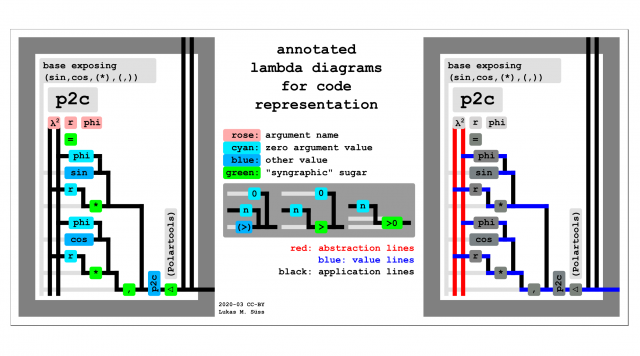
For details see: ALDs – example Cartesian to polar.

For details see: ALDs – example quicksort.
Annotated lambda diagrams (ALDs) are a "code projection" that aims at being highly enjoyably usable for telling computers what to do (aka coding/programming/automating/...)
Annotated lambda diagrams where inspired by plain unannotated lambda diagrams (PLDs)
These are presented by John Tromp on his homepage here: https://tromp.github.io/cl/diagrams.html
These plain lambda diagrams are are in turn based on lambda calculus.
A formalism with only three types of terms that can represent any kind of computation in a very minimalistic way.
The annotated lambda diagrams presented here add annotations and some minimal some "syngraphic sugar" to plain lambda diagrams.
The idea is to make lambda diagrams it into a really enjoyable programming interface that minimizes discontinuous visual jumps and minimizes
the necessity of expending mental resources on navigating codebases. A "bicycle for the mind".
For an introduction maybe first read:
Unfortunately as of yet (2021-07) this is all still "vaporware" and only static non-interactive mockups.
The author may never come around to actually implement this programming interface as envisioned.
This is a mammoth project, and this wiki already eats up a big chunk of time.
But at least with these mockups I hope to get the idea out there.
We really really need software that is not broken in a future world where matter essentially becomes software.
The basic idea in brief bullet points
- annotate plain lambda diagrams with: variable names, types, current values, kinds (aka types of types), ... (not all shown per default of course)
- Make them into a structured editor where you can type normally pretty much as you would in "plain textfile code editing"
– (See: Fructure Specifically in this video with Andrew Blinn shortly after 6:03 [1] where he says "My preferred alternative is to simply type normally") - Add progressive exposure without compromises!!! This is not negotaible.
- Make program fragments drag and drop interactive (like puzzle pieces)
Give reasonable visual cues for efficiency (rather than fancy): identicons, arity mismatch visualization, ... - Give ALDs typed holes of input holes, output holes, and bridge holes. Don't forget the bridge holes!
Such that program fragments are extendable: upstream, downstream, and ...
can also be tied up in one or more still open concurrent paths (wiki-TODO: make a sketch) - (Eventually make data flow around holes as far as this is possible. See: Hazel)
- Add type directed context sensitive suggestions for extending onto the present holes
- Give ALDs a zooming user interface (ZUI) capability – that allows for (arbitrarily deep) in place evaluation preview
- Add inverse tabs – allowing to navigate the codebase-graph upwards along different upstream paths that where formerly traced downstream along some dependency tree
(Some dependency tree is only a subset of the codebase graph. This needs more awareness.) - Use an ultra finegrainedly content addressed programming language as a base!!!
That in order to mop up with fragility of references, dependency hell and fix quite a number of other things too.
(ony such language in construction as of 2021 seems to be the unison language)
Eventually add higher level data visualization:
- that follow code structure (see: Tangible values – by Conal Elliott) – but with added progressive exposure.
- that give an immediate connection by bidirectional data-flow (see: Drawing Dynamic Visualizations – by Bret Victor) (See: enso language)
Totally trearing down the GUI vs commandline rift!
The idea is as follows:
If all progressive exposure is closed then the UI is completely indistinguishable from a conventuinal GUI.
Except one little "+" or something as the starting point for progressive exposure.
A progressive exposure step opens up the ALD that corresponds to the visual element.
From there the "end-user" (now elevated to "deveuser") can trace the codebase to non-displayed or even non-visual code elements.
Trace via the the nicely visually traceable lines in the ALD.
Exposing enough GUI elements and hiding the visualization one eventually ends up with Just ALDs or
some other code projection like conventional purely textual ones.
Add to that: Bookmarking of "interface visualizations" and
organizing "code" documentation and data storage in a desktop wiki like system that
is implemented in that whole programming system in a bootstrapped way.
The basic benefits
Combines the best of the two worlds of textual and graphical code:
- Almost as traceable as graphical code (since there are traceable "program circuit" lines)
– these lines are quite different to "conventional" graphical programming though - Almost as scaleable as textual code (since the structure closely follows textual code) – a little less dense
Does NOT combine the worst of the two worlds:
- unscalability of graphical wire-monster-krakens and
- hard tracability of excessively indirected textual codebases)
- Seeing the whole code multiverse at a glance and and the live running state as a literal "red thread" within.
- Browsing the codebase in all dimensions without detours and disruptive jumps
Human mental RAM is limited, it shouldn't be used for pointless navigation hurdles.
Mockup Demos
Note: If actually implemented all this should be dynamic and interactive
Drag and drop interaction with program fragments and typed holes
Moving program fragments through programs and linking them up via typed hole connection ports
Dragging the function f12 (upper right) into an other yet incomplete function f14 where the types (T1 and T2) match up and connections snap in place. Imagine the whole thing interactive and animated. As soon as f12 is dragged into the box of f14 it'd get displayed in the same simplified way ad f23 already is. This is not shown. Dragging f12 around in the box of f14 will move stuff around to make space accordingly.
Wrong connections can be enforced this will make explicit typed holes of bridge type (bridge holes). Not shown.
- Grey cross upper right means this function is expanded and its definition is shown
- Grey shuriken like star upper right means this function is collapsed and its definition is hidden
- Note how f12 (once dropped into f14) gets added to the collected semi-implicit dependencies of f14 (light grey annootations)
Dragging "bridge-holes" or "gap-holes" through still ambiguous sections of the code
Visual cues employing human image reconition skills – identicons and arity cues
Zooming user interface (ZUI)
From in scaled down place preview to zooming user interface
This mockup was put together in order to illustrate how annotated lambda diagrams would allow for
an (adjustably) scaled-down in-place preview of functions on which the currently looked at function depends on.
Specifically this random example code (the "replicate"-function) takes a value and a natural number and
returns a list of copies of that value with the length of that natural number.
In place preview:
Check out the "replicate"-function (grey border).
Looking closely into the expanded version (second from left) you can see:
- the scaled down "in place preview" of the "take"-function (blue border) and
- the scaled down "in place preview" of the "repeat"-function (red border)
This is not yet an evaluating substitution!
Note that (despite this looking like a substitution) this is only just a yet-unevaluated in-place-preview.
This is important. This is very different to "conventional" box and wire graphical programming.
(matching the structure of the plain lambda diagrams)
Actual honest-to-goodness evaluation amounts to short-circuiting:
- vertical-abstraction-lines (always on the right) with
- vertical application-lines (always on the left).
That entails:
- all abstraction lines of the substituted in function that got saturated just vanish (note that partial application is allowed)
- what was formally supplied via the lines now gone is now supplied by the abstraction lines of the callee
- former guts of the now substituted-in function are now arbitrarily complexly intertwined into the calling function
Note that with true substituting evaluation there is a loss decomposition.
Creating complex patterns from simple rules is the point of programming after all.
Is this true?: Classical box-and-wire graphical programming cannot make a distinction between in-place-preview and actual substitution?
If so we might be onto something here.
Annotated lambda diagrams with zooming user interface as a window into the entire control flow multiverse
The desire here is to implement in place previews (with adjustable relative scaling factor)
to annotated lambda diagrams in such a way that:
- in place previews can be arbitrarily deeply nested.
- one can zoom-travel though all of this via a global zoom going across all nesting levels (at least global in a viewport window)
The representation would allow for visualization of the activity of the garbare collector.
Some of the massive practical challenges in implementing an ALD-ZUI:
Typical graphic GUI libraries are totally
- not built for zooming user interface (ZUI) like zoomability and
- not built for displaying very very big numbers of elements.
Even with special purpose solutions it is difficult ...
A naive redraw of the whole screen for every frame (as often done in computer games)
is is not a viable option (for anything beyond an interactive mockup prototype).
Instead usage of off-screen graphic buffers is essential – partially updated not fully redrawn
(this is e.g. not supported by the webgl wrapper-libraries of the elm language as of 2021 – learned the hard way).
Redrawing only the changing graphic details on mutable graphics-buffers
can easily lead to graphic glitch like artifacts from bugs if not done
with proper fool-proof usually performance expensive abstractions.
Further adding to the difficulty here.
The design choice for off-screen partially updated graphic-buffers becomes necessary due to the following challenges and requirements:
- With tree like visual nesting the amount of elements displayed on screen can grow very fast to seriously problematic numbers.
- In a live coding mode (that should be supported) a lot of the displayed elements may need to be refreshed at a high frame rate.
- As soon as the computer idles the CPU/GPU load should drop to near zero because this is not a computer game where permanent high load is acceptable.
Furthermore:
Regular rescaling of the zoom level during intense zoom-navication is essential. This is:
- to prevent very quickly running out of the number-range that float-values can represent without rounding errors
- to make dropping off (or heuristic pre-loading) of parts of the visualization easier that are way too small or way too big to see.
Notice the interesting duality of:
- the type-constructors used to construct a value in the "demo" function – constructive corecursion
- the case-of type-destructors used to destruct that value in the "showBinFancily" function – destructive recursion – handleCases
Maybe interesting side-note:
There is definition by (not necessarily terminating) recursion present here.
There are ways to avoid "definition by recursion" alltogether.
All that is needed is a termination case and a provable overall monotonous approach towards that termination case.
Well, these can be obfuscating and brain bending.
This is related to:
- "dependent type theory"
- total programming – provably terminating (necessarily turing incomplete subset)
- the book: "The Little Typer" (official website for the book) (the pie language on guithub - a minimum viable dependently typed language)
(docs on implementing such a language – by David Thrane Christiansen – implementation language is Racket a scheme/lisp dialect) - the dependently typed programming language "idris"
"Inverse tabs" for browsing the whole codebase graph rather than only the local code dependency tree
The obvious code navigation options include:
- Tracing down to the codebase into the dependencies (the functions that the currently observed function depends on) and going back up that same path again.
- Following the codebase along the some execution trace.
This is not enough!!
We need "inverse tabs".
We want also be able to quickly jump to functions that answer the question:
What other functions do call this function too that we currently look at?
By switching over to a different "inverse tab" one keeps looking at the same function in the tab but
the whole surrounding (visually represented) context gets switched out.
So when zooming out by scrolling one goes a different way in the codebase.
Essentially this gives one access to the whole directed graph of the codebase not just to a local dependency tree.
Inverse tabs are indicated in the mockup graphic about "peering into the control flow multiverse" at the lower left.
To make it easier to reference to a yellow killroy face has been added.
(wiki-TODO: Make a new mockup focused on showing the idea of inverse tans better.)
Mockups regarding Conal Elliotts work
Tangible values (TVs)
The desire:
Totally obliterating the GUI-vs-commandline rift by combining tangible-value-GUIs with a spectrum of code projections all the way to textual.
Annotated lambda diagrams sitting smack in the middle between graphical and textual.
Priority #1:
- Investigate Conal Elliots work about "tangible values" in the context of ALDs
Tangible values may give a GUI that is pretty much indistinguishable for the GUI's we have today.
But with all windows and graphical elements "secretly" being tangible values in the background.
Assuming the inverse operation of tangible-value-fusion (let's call it "fission" here) is implemented too (which absolutely must be done IMO)
then the tangible values (as GUI elements) already come with some progressive disclosure.
Progressive disclosure by "fission" can only expose things that do have already implemented graphical representations though.
So my idea here (beyond what Conal Elliott presented in his demo "Eros") is to allow for progressive disclosure of the code
that is associated with the tangible not just via fission but also via annotated lambda diagrams (and even textual code projections if so desired).
(Which come with their own mean of progressive disclosure that is ZUI zooming)
Any combination goes. (only TV, ALD+TV, only TV – having relative scaling adjustable should be useful e.g. by local scrolling)
Related notes:
- Default values (for looking at a slice of a stateless tangible value) are living outside the stateless realm.
They can be stored on disk as additional necessarily stateful data. - Code flowing around holes on the data level rather than the type level (See: Hazel) might be very useful.
Compiling to categories
Priority #2:
- Investigate Conal Elliots work "Compiling to Categories" (which is abstracting with closed cartesian categories CCCs over lambda calculus)
But that done from within ALDs (which essentially are lambda calculus)
Out of this reason this likely won't yield a nice representation. Maybe? Still interesting to investigate.
Beautiful differentiation
Priority #3:
- Investigate Conal Elliots work "Beautiful differentiation" – Will just turn into a library I guess
Overloading the meaning of the lines – (applicative funtors, monads, ...)
(wiki-TODO: add the mockup showing a monad in lambda diagrams)
Mockups still TODO
- Continuous transformation from the abstract syntax tree (a s a most direct code projection) to ALDs as code projection
- Representation of "algrebraic effects (or abilities)" in ALDs (maybe not a nice match – unfortunately ...)
- Investigate representation of typeclasses in ALDs (typeclasses similar to what is present in the programming language haskell)
Mockups regarding maybe not so practical stuff
- Church encoding in lambda diagrams – more efficient binary encoding
- Encoding of list and enums (product types and sum types respectively) – there's a certain interesting asymmetry in minimal encoding (wiki-TODO: dig that out and link it here)
- What about progressive exposure all the way down to the bits and bytes of an open source processor with extensionally equivalent naive inefficient implementations both serving as documentation but still switchable in – Related: Multiplication circuits (and their surprising richness), Ternary logic, p-adic numnbers, ...
Warning! you are moving into more speculative areas.
- Relation of typed holes to the void type, absurd function and the like – "void" being sort of on the top of the infinite pecking order: type, kind (type of type), sort (type of type of type), ... not inside of any provably terminating "toy formalism"
Notes on conventional/classical "graphical programming" code projections
Conventional graphical programming typically follows the scheme of data-wires and function-boxes.
Thee are approaches that reverse that function-wires and data-boxes but that seems just bad in a different way.
Note: Assuming a function B (represented as a box) has an input that accept a function as an input (that is the function is a so called "higher order function")
then the wire transmitting some other input function to that input is still a "data wire"!
In contrast a function wire is a wire that represent a data-transformation itself.
(Most graphical programming tools do not even allow for using data wires as channels for transmission of functions.)
Annotated lambda diagrams (only a "semi graphical" code projection)
have inherently integrated the capability of overloading the meaning of the graphical lines that connect to other lines.
E.g. monoids, applicative functors, monads, ...
What may seem like boxes are just annotations of the lines.
That is removing the boxes the code still works.
That is not the case for classical graphical programming.
This can be done in classical box and wire representation too.
But it is not inherent. That is not something what one would implement in an naive approach.
And thus it is has rarely (never?) been done.
One concrete case of a programming language attempting that is the (multi representational) language called enso (formerly luna).
What is truly unique to ALDs -- the semi graphical code projection of ALDs is that
Abstractions and applications remain separate in the graphical representations.
(TODO: think about why this might be the killer advantage over box and wire representation)
Related
External links
A basic write-up of some ideas with links to twitter posts.
(wiki-TODO: this needs to be published more properly (that is: more resilliently))
Zooming user interface:
For many user interfaces this idea seems rather impractical.
It is likely extremely useful for the case of ALD's though.
Table of contents
Contents
- 1 The basic idea in brief bullet points
- 2 The basic benefits
- 3 Mockup Demos
- 3.1 Drag and drop interaction with program fragments and typed holes
- 3.2 Visual cues employing human image reconition skills – identicons and arity cues
- 3.3 Zooming user interface (ZUI)
- 3.4 Mockups regarding Conal Elliotts work
- 3.5 Overloading the meaning of the lines – (applicative funtors, monads, ...)
- 3.6 Mockups still TODO
- 3.7 Mockups regarding maybe not so practical stuff
- 4 Notes on conventional/classical "graphical programming" code projections
- 5 Related
- 6 External links
- 7 Table of contents
